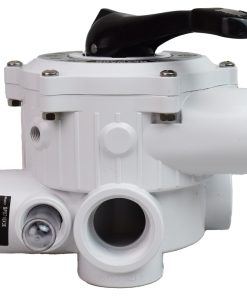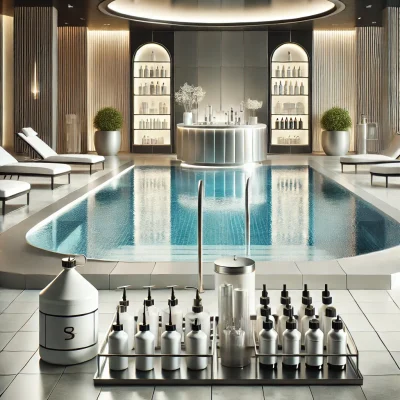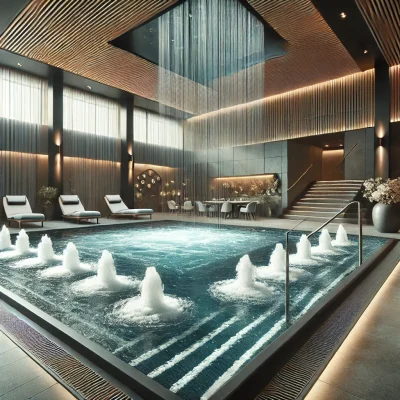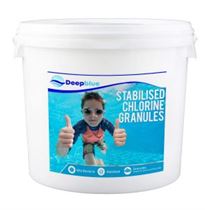Spa Pool Operation: Best Practices for Safety and Hygiene
Once your spa pool is designed and commissioned, the focus shifts to its daily operation. This blog post details the best practices for operating a spa pool safely and hygienically, with guidance from the Health and Safety Executive (HSE) to help you ensure a pleasant and safe spa experience.
Importance of daily operation and monitoring
The daily operation of a spa pool is essential for maintaining water quality and reducing the risk of infection. The warm, turbulent waters of a spa pool can quickly become a breeding ground for bacteria if proper practices aren’t followed [2]. Regular monitoring and adherence to best practices are key to preventing issues [22, 43].
Key operational practices for spa pools
Effective spa pool operation involves several daily tasks and procedures. Some of the most important practices are outlined below:
- Bather Load Management: Adhere to the spa pool’s design bather load to avoid over-crowding. This should not exceed the number of seats and loungers [71]. The design bather load should be approximately 10 times the capacity of water in the spa-pool system when measured in cubic metres [11].
- Water Replacement: Make sure to replace the water as recommended for the bather load. In commercial settings, the water needs to be replaced with fresh water when the bather load equals 100 times the water capacity in cubic meters [35]. In hot tubs used as part of a business the water must be replaced each week or after each group of users, whichever is shorter [18].
- Water Quality Checks: Check water clarity, chemical levels, and make sure the dosing systems are working effectively [22, 43]. Test pH and disinfectant levels daily [43].
- Cleaning: Routinely clean the waterline, overflow channels, skimmers, and surrounding areas, at least daily, to prevent the build-up of contaminants [27].
- Filtration System Management: Backwash filters daily, making sure to allow the filter media to settle before using again [19, 20, 27]. Clean or replace cartridge filters as necessary [22, 27].
- Dehumidification: Ensure there is adequate dehumidification and ventilation, if the spa pool is located indoors [52, 72].
- User Information: Provide users with necessary information on hygiene, bathing times and any important advice for using the spa pool correctly [73, 74].
Important aspects of water treatment
Water treatment is essential for the safe operation of a spa pool. Here are the main aspects of water treatment:
- pH Balance: Maintaining the pH between 7.0 and 7.6 is vital. This is because the pH levels have a significant impact on the effectiveness of the disinfectants [24, 26].
- Disinfection: Disinfectants like chlorine or bromine must be used correctly to prevent microbial growth. The amount of disinfectant should be monitored, and the water should be continuously treated [23, 24, 29].
- Total Dissolved Solids (TDS): TDS should be kept at acceptable levels by replacing the water as recommended [38].
How to deal with an emergency
Every spa pool should have a documented emergency action plan. This plan should address issues like:
- Chemical Spills: Procedures for dealing with spills of pool treatment chemicals [75, 76].
- Contamination Incidents: Plans for dealing with contamination, such as a microbiological issue with the pool water [65, 75].
- Equipment Failure: Contingency plans in the event of equipment failure [75].
The emergency procedures should include actions to mitigate the risk of the incident, limit any health risk and restore the pool to normal [77].
Final thoughts
Operating a spa pool safely and hygienically requires attention to detail and consistent adherence to best practices. Regular water testing, correct water treatment procedures and proper management are the key components. Remember to check back on thepoolcleaners.co.uk for more guidance and information on how to maintain your pool and spa.
FAQs
What is ‘design bather load’ and why is it important?
Design bather load is the maximum number of bathers using the spa per hour, and should not be exceeded to maintain water quality. A higher bather load will require a higher rate of water replacement and more effective disinfection [11, 71].
Why should I replace the spa pool water regularly?
Regular water replacement helps to remove contaminants and keeps the water safe and fresh. The correct frequency of water replacement will depend on the type of spa pool and bather load [18, 35].
What are the ideal pH and disinfectant levels for spa pool water?
pH levels should be kept between 7.0 and 7.6, and disinfectant levels should be maintained at 3-5 mg/l for chlorine and 4-6 mg/l for bromine [24, 26].
What should be included in a spa pool emergency action plan?
The emergency action plan should include details about dealing with chemical spills, contamination incidents and equipment failure. The procedures should help to mitigate the risk, limit the harm to health and allow the pool to be restored to normal [75-77].
 Certikin 90 / 75 X 63Mm Pvc-U Reducing Socket Plain (SPX090063CRS)
1 ×
Certikin 90 / 75 X 63Mm Pvc-U Reducing Socket Plain (SPX090063CRS)
1 × Plastica Hayward 710 1.5in Multiport Valve Sidemount
1 ×
Plastica Hayward 710 1.5in Multiport Valve Sidemount
1 ×
 Plastica Hayward 710 1.5in Multiport Valve Sidemount
Plastica Hayward 710 1.5in Multiport Valve Sidemount 










